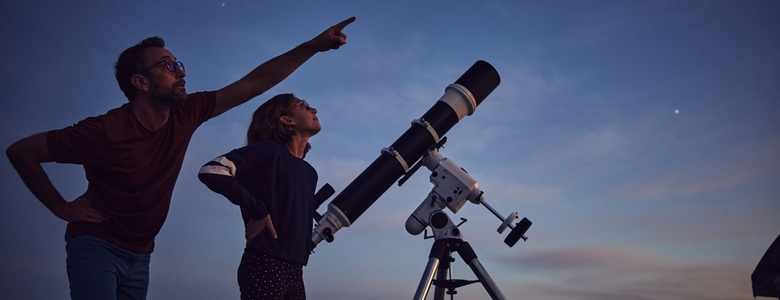13 March 2023
5 astronomical events to look out for in 2023
;)
Photographs of the northern lights usually capture shimmering green skies over the snow-capped glaciers of Iceland. But in late February, a large solar flare created the perfect conditions for the phenomenon to be visible across the UK.
This uncharacteristic appearance generated a lot of interest in the night sky and you may be wondering what other astronomical events you can witness this year.
Luckily, 2023 will be packed full of meteor showers, supermoons, and rocket launches.
Here are five of the best astronomical events to look out for in 2023.
1. See Venus and Mercury
Technically, Venus and Mercury are visible to the naked eye – albeit faintly. Both sit close to the sun, though, so viewing them can damage your eyes. Staring directly at the sun is never a good idea.
There are times during their orbits when they are further from the sun and brighter in the sky, so it’s easier and safer to view them.
On 4 June, Venus will reach its greatest eastern elongation – the furthest point from the sun on its elliptical orbit. It should still be clear and visible in the night sky after sunset, so this is your best chance to spot it.
Don’t worry if you miss it in June, as you’ll get another chance on 23 October when it reaches its greatest western elongation. This time it will be a morning star, visible early in the day.
Mercury is smaller and harder to find in the sky, but you have more opportunities. The greatest eastern elongations, when Mercury is visible at night, are on 11 April, 10 August, and 4 December. If you want to see Mercury in the morning, be up bright and early on 29 May and 22 September for the greatest western elongations.
2. Find another galaxy
Finding another galaxy is surely high up on any stargazer’s bucket list.
On 21 March, another new moon will light up objects in deep space, making them visible with binoculars or even with the naked eye in dark spots.
Look north-west just after sunset and you may see an elongated oval with a bright core. This is the Andromeda galaxy, the nearest galaxy to the Milky Way.
3. Watch the Lyrid meteor shower
There are several meteor showers to see in 2023, but the Lyrids are one of the most vibrant. It’s also the oldest recorded meteor shower. The event comes from a comet that orbits the sun once every 415 years and was first recorded in 687 BCE.
Though it’s not the most active event, the meteors have glowing dust trails that linger in the sky, creating a beautiful visual spectacle.
The Lyrids will be visible from 14 to 30 April and most active from 22 to 23 April.
4. Experience a supermoon
The moon’s orbit is elliptical, with a closest (perigee) and a furthest point (apogee) from the Earth. When it is at its closest point – and also in a full moon phase – we get a supermoon. There are two opportunities to experience a supermoon, on 1 August and 31 August.
Often, they slip by unnoticed but the moon will be 14% larger and 30% brighter than a standard full moon, so you should see a difference if you pay attention.
Historically, supermoons are linked to strange, unpredictable behaviour, so it might be best to avoid making any big financial decisions on these days!
5. See the launch of Nasa’s Psyche mission
Nasa has several exciting milestones planned for 2023, including the launch of the first fully 3D-printed rocket in March. Their recent missions focused on exploring planets like Mars and Venus but their upcoming Psyche mission is headed for an asteroid instead.
The October 2023 launch will send a probe to Psyche, an asteroid made mostly of iron, in the belt between Mars and Jupiter. While this may not sound very exciting, it could hold the key to understanding how Earth and the rest of the planets in the solar system were formed.
Iron is a key element that makes up the core of rocky planets, including our own. So, Psyche could be a remnant of an old planet or the beginnings of a new one.
Once the probe reaches it in 2029, it may give us a much deeper understanding of the history of our solar system. If it does, the launch in 2023 will be a pivotal moment in science. Either way, the spectacle of a rocket launch is something you won’t want to miss.
If you happen to be in Florida at the time, you can view the launch in person at the Kennedy Space Centre. If not, you can also see a live stream on the Nasa app.
Category: Lifestyle, News, Wellbeing
